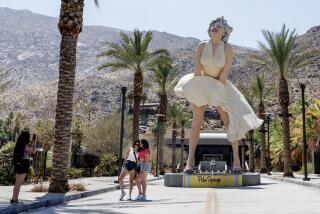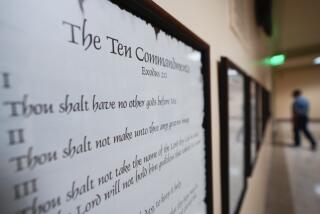A Monument Goes, but Not the Controversy
MONTGOMERY, Ala. â Workers wheeled a Ten Commandments monument out of the state Judicial Building rotunda on Wednesday, ending a noisy standoff, if not the broader debate over religious displays in public buildings.
The 2 1/2-ton monument, at the center of a nationally televised tug of war, was moved to a private room inside the court building to comply with a court order that it be taken from public view. Religious activists were kept outdoors, helpless to make good on vows to block the monumentâs removal with their bodies if necessary.
Monument supporters, who had stood vigil in the sun-seared plaza in front of the building for more than a week, decried the removal and vowed to fight on.
âItâs a sad day for Alabama,â said state Sen. Henry E. Erwin Jr., a Republican who supported the Ten Commandments display. âWe had a chance to stand very tall.... And we basically backed down.â
The state was under a court order to move the monument after a federal judgeâs finding that it represented an unconstitutional use of public facilities to promote religion. But Alabama Chief Justice Roy Moore, who installed the monument two years ago, refused, setting up a showdown that drew several hundred Christian backers from across the country.
After Moore ignored a deadline for removal Aug. 20, all eight associate justices stepped in and ordered the building manager to take the monument away to prevent court-imposed fines of $5,000 a day. The action Wednesday all but assured that Moore and the state will avoid having to pay.
âWeâre delighted they were able to come to compliance with the court order. Our hope was they could do so without incurring fines,â said Richard Cohen, general counsel of the Southern Poverty Law Center, one of the groups that sued to have the monument removed.
Cohen said he would examine the new location to ensure it complies with the mandate.
âIt will satisfy us if that room is out of public view, locked and not available on demandâ to members of the public, he said.
The Rev. Barry W. Lynn, executive director of Americans United for Separation of Church and State, which also was part of the legal battle against the monument, applauded the removal.
âThis is a great victory for the concept of real religious freedom and for the principle that no judge is above the law himself,â Lynn said.
Lynn accused Moore of political grandstanding and said he should go, too.
âI do hope we manage in this process ... that Judge Roy Moore will be looking for another job and that he will be removed,â he said.
Moore was suspended Friday as he awaits a hearing by a state judicial-review panel into whether he violated state ethical standards by defying the federal order. The ethics complaint against Moore was filed by Stephen R. Glassroth, an attorney who was a plaintiff in the suit to remove the monument.
Moore has been steadfast, saying the federal court lacked jurisdiction in the matter. He has said he will ask the U.S. Supreme Court to settle the wider question of religious displays in public buildings.
Moore defends the monument as a representation of the biblical underpinnings of secular laws, noting that Alabamaâs state constitution mentions âthe favor and guidance of Almighty God.â
In a written statement Wednesday, Moore said, âIt is a sad day in our country when the moral foundation of our law and the acknowledgment of God has to be hidden from public view to appease a federal judge. I am profoundly disappointed with our governor, our attorney general and the associate justices of the Alabama Supreme Court who have allowed the basis of our justice system to be undermined by a federal judge who says that we cannot acknowledge God.â
Workers used a hydraulic lift to move the 5,300-pound granite monument. Erwin, the state senator, said it was initially put in an employee lunchroom but was to be moved to a windowless press room, under lock and key, for longer-term storage. The monument, which is made of two pieces, was disassembled so it would fit through the door.
Outside the building, Christian demonstrators who have kept watch through the glass front doors spent much of the day in prayer.
Many had flown or driven from other states to join the protest, praying, listening to speeches and waving placards in the face of dwindling odds of success.
The U.S. Supreme Court declined to step in to keep the monument in place last week. The demonstrators got more bad news Wednesday when a federal judge in Mobile, Ala., threw out a last-minute lawsuit seeking to block the removal on religious-freedom grounds.
Among those in the crowd Wednesday afternoon was Christopher James Gill, 38, who had just driven his station wagon from Travelers Rest, S.C. He brought along a prayer rug and several Bibles, a wooden cross and a sign that said, âIn God We Trust.â The monument had been moved by the time he arrived.
âI donât believe God is happy with the judgment,â Gill said.
The demonstrators said they werenât done battling yet. The Rev. Patrick J. Mahoney, director of the Christian Defense Coalition, said activists would use the issue as a litmus test for political candidates in Alabama.
The demonstrators have taken aim at Atty. Gen. Bill Pryor, who has voiced support for public Ten Commandment displays but urged removing the monument to comply with the order issued by U.S. District Judge Myron H. Thompson.
Pryorâs nomination for a seat on the U.S. 11th Circuit Court of Appeals was stalled by Senate Democrats who took issue with his conservative views on issues such as abortion.
Sloan reported from Montgomery, Ellingwood from Atlanta.
More to Read
Sign up for Essential California
The most important California stories and recommendations in your inbox every morning.
You may occasionally receive promotional content from the Los Angeles Times.










